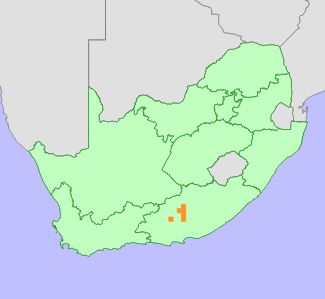|
Scientific Name | Euphorbia polycephala Marloth |
Higher Classification | Dicotyledons |
Family | EUPHORBIACEAE |
National Status |
Status and Criteria | Vulnerable A2ac |
Assessment Date | 2019/11/09 |
Assessor(s) | L. von Staden |
Justification | There has been at least a 30% reduction in the Euphorbia polycephala population in the last two generations. This is inferred from severe declines that have been noted within the historical range of this species, with 40-50% of subpopulations recorded as declining or extinct. Monitoring of a subpopulation on a farm near Pearson recorded a 90% decline in 10 years. Reasons for declines include droughts, damage by browsing livestock and burrowing ground squirrels. However, a number of relatively large, healthy subpopulations have been discovered recently and these appear to be stable. It is therefore listed as Vulnerable under criteria A2ac. |
Distribution |
Endemism | South African endemic |
Provincial distribution | Eastern Cape |
Range | This species is endemic to South Africa, and is found from Pearson to Cradock and Somerset East. |
Habitat and Ecology |
Major system | Terrestrial |
Major habitats | Eastern Upper Karoo, Eastern Lower Karoo, Karoo Escarpment Grassland, Southern Karoo Riviere |
Description | It occupies karroid shrubland and thicket, on rocky hills and flats. |
Threats |
| Euphorbia polycephala is threatened by ongoing habitat degradation, trampling and browsing as a result of heavy grazing by livestock. |
Population |
Concern over the future survival of Euphorbia polycephala was already expressed in 1941 (White et al. 1941), when extensive destruction of known subpopulations through browsing livestock including donkeys, sheep, goats, cattle and ostriches were ongoing. Farmers used plants as fodder during droughts. In 1988, no subpopulations could be found in the area along the valley of the Great Fish River between Witmos and Halesowen south of Cradock and the species was thought to be locally extinct in this area (Court 1988). A small subpopulation of about 25 plants was rediscovered near Halesowen in 1998 (Pritchard and Pritchard 1998).
A large subpopulation on the farm Cranemere was found to be in decline in 1988, with more than half of the subpopulation dead at that stage, and only about 80 plants remaining (Court 1988). This subpopulation declined further to less than 10 plants in 1998 (Pritchard and Pritchard 1998). The cause for decline appeared to be burrowing ground squirrels that cause damage to plant roots. Based on this, a population reduction of at least 30% over two generations is inferred.
Most remaining subpopulations of this species are very small and isolated, but at least four healthy subpopulations remain that not currently threatened. Awareness among local landowners of the threatened status of this species led to most of these subpopulations now being well protected (G. Marx pers. comm.).
|
Population trend | Stable |
Assessment History |
Taxon assessed |
Status and Criteria |
Citation/Red List version | | Euphorbia polycephala Marloth | VU A2ac | Raimondo et al. (2009) | | Euphorbia polycephala Marloth | Vulnerable/Endangered | Hilton-Taylor (1996) | |
Bibliography |
Court, D. 1988. Euphorbia polycephala at Cranemere. The Euphorbia Journal 5:39-42.
Hilton-Taylor, C. 1996. Red data list of southern African plants. Strelitzia 4. South African National Botanical Institute, Pretoria.
Pritchard, D. 1996. Euphorbia polycephala: a rare and endangered plant? Euphorbiaceae Study Group Bulletin 9(1):14-19.
Pritchard, D. and Pritchard, A. 1998. A survey of the habitats of Euphorbia polycephala. British Cactus and Succulent Journal 16(4):190-192.
Raimondo, D., von Staden, L., Foden, W., Victor, J.E., Helme, N.A., Turner, R.C., Kamundi, D.A. and Manyama, P.A. 2009. Red List of South African Plants. Strelitzia 25. South African National Biodiversity Institute, Pretoria.
White, A., Dyer, R.A. and Sloane, B.L. 1941. The succulent Euphorbieae (Southern Africa) Volume II. Abbey Garden Press, Pasadena.
|
Citation |
| von Staden, L. 2019. Euphorbia polycephala Marloth. National Assessment: Red List of South African Plants version . Accessed on 2025/09/17 |
 Comment on this assessment
Comment on this assessment


